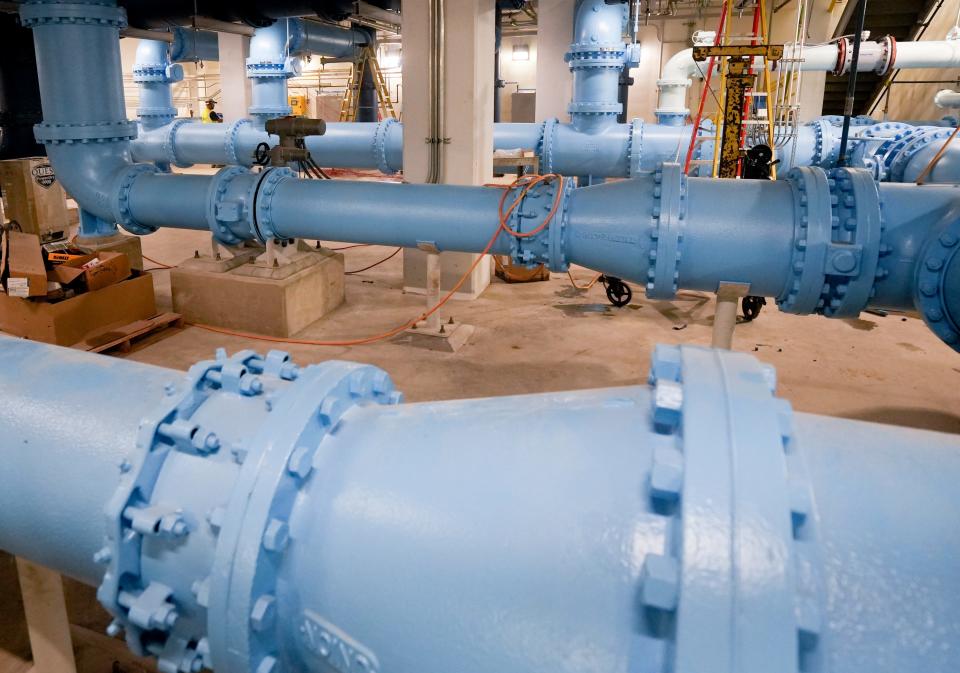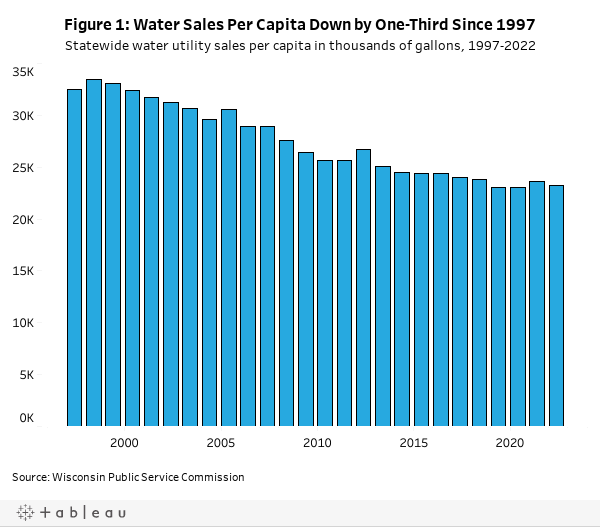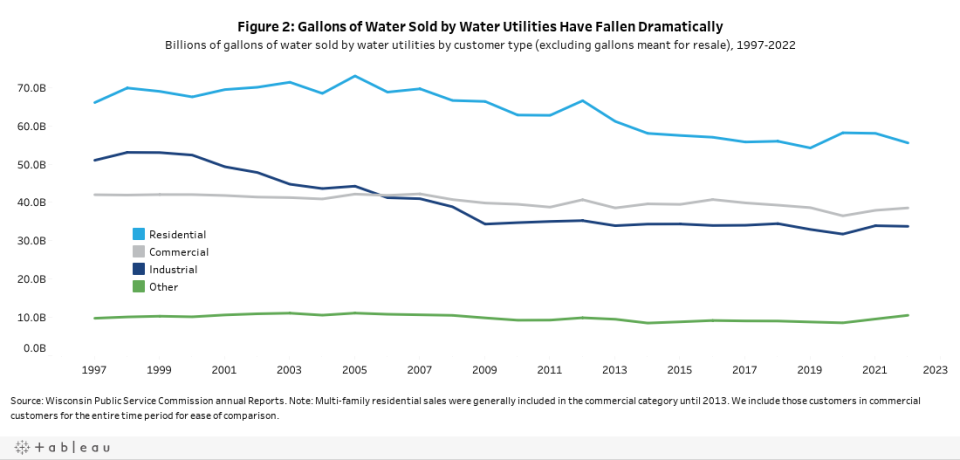How Wisconsin has achieved big gains in water conservation and how that could help in the future
MADISON - You may remember those commercials from your childhood, reminding you to turn the faucet off when you brush your teeth. Or maybe you purchased a lower-flow showerhead in a bid to be a little more conservation-friendly.
It turns out those actions may have had an impact on how much water gets used in Wisconsin.
A report, released by the nonpartisan Wisconsin Policy Forum, details just how much Wisconsin's water usage has dropped since the late 1990s, and which sectors have created the largest drops.
Here's what you should know.
How much have water sales fallen in Wisconsin?
Since 1997, which was the first year water sales data from public water utilities to residents and businesses was collected, sales have fallen by about 18%, or 30.4 billion gallons, according to the report. That's nearly the same amount of water that is held in Lake Monona in Madison.
The record low for water usage was 134.6 billion gallons in 2019, but 2022 was nearly as low at 138.4 billion gallons. That's down from 175 billion gallons in 1998.
On a per capita basis, the drop is more pronounced at 28.5%, from just over 33,400 gallons per person in 1998 to 23,300 in 2022.
Why is water use falling in Wisconsin?
A part of the reason, the report says, is an increased efficiency in water use. Between 1997 and 2022, Wisconsin's population has grown, while residential water purchases have dropped by 10.5 billion gallons or 16%.
Per capita, residential purchases have declined 27%, from nearly 13,000 gallons per person in 1997 to just over 9,300 last year.
"The long-term declines in residential use can be attributed, at least in part, to water conservation legislation at the federal level and other efforts to require and encourage the installation of low-flow showerheads, toilets, and appliances," the report says.
"Other contributing factors may have included more aggressive efforts by citizens to fix leaks and to engage in water-conscious behavior, such as reduced watering of plants and lawns, in light of the positive impact of reduced water use on the environment and family budgets, especially as water rates rise."
On the commercial side, water use has dropped as well, falling by 3.4 billion gallons over the last 25 years, the report says. While that was a smaller drop, it was still notable. Commercial uses of water include restaurants, retail locations and other businesses.
More: Residents in a Wisconsin town with extreme PFAS contamination file lawsuit against paper mill
How have industrial users dropped their water consumption?
Industrial water usage has dropped the most, according to the Policy Forum, by more 17.2 billion gallons, or 34%.
That drop is due to more than just water conservation. The overall drop in water use is also due to a decline in overall industrial activity, the report says, especially in water-intensive areas such as papermaking and food production.
Plant closures have also played into the drop in water use. For example, when the papermill in Brokaw closed in 2011, water sales dropped by 92% between 2005 and 2006, and in 2019, the water utility was completely shut down.
But in addition to closures and a drop in industrial activity, industrial water users have also become more efficient in their water use, too.
Have there been spikes in water usage throughout the overall downward trend?
Yes.
Water use still rises and drops depending on things like heat waves or droughts that lead to more residents watering their plants and lawns. The COVID-19 stay-at-home orders also caused a 7.3% increase in annual residential water use in 2020, which remained steady in 2021 before it tapered off in 2022, the report said.
What kind of impacts is the drop in water use causing?
Dropping water use is definitely good for the conservation of water resources. Though Wisconsin isn't facing water shortages, the drop in water consumption means that lakes, rivers and groundwater aren't depleted as quickly.
It also means there are opportunities to serve new homes and factories more cheaply, the report says, lower energy use by water utilities to pump and treat water, less stress on sewer systems and treatment plants, and fewer disruptions to aquatic ecosystems.
"As the climate warms and drought becomes more likely across the country and here in Wisconsin, stable access to clean water could make the state more attractive to residents and businesses," the report says. "Looking at these data can help policymakers monitor and tout this advantage, plus they provide some insight into other trends such as the trajectory of manufacturing in the state and the impact of COVID-19 on people’s daily habits."
But the drop in water use has also caused hardships for water utilities, making it more difficult to cover operating costs or finance major capital improvements such as the replacement of lead lateral lines, according to the report.
What is the average cost of water in Wisconsin?
Wisconsin's statewide average water rates in 2020, adjusted to 2023 dollars, were about $58.80 per month for residential customers using about 5,000 gallons a month, the report said.
That number is higher than other Midwestern states, such as Iowa with an average of $56.00, and northeast Illinois is $57.81, but lower than states such as California, which averages about $94.94 for 5,000 gallons of water.
"As conservation efforts continue, it’s likely these rates will rise further," the report says.
More: Waukesha's lake water is coming. What to know about potential problems and solutions.
Water utilities aren't the only ones that draw water. Where else does it get used?
Water utilities aren't the only users of water — in fact, they only use about 11% of the 1.77 trillion gallons of water used in 2021, according to the Policy Forum.
The biggest users are actually power generation and agricultural irrigation, which is tracked by the Department of Natural Resources. Power plants account for 73% of total water withdrawals to generate electricity, the report says.
Agriculture accounts for about 4% of the state's annual water use, excluding cranberry production, which accounts for another 3%. Paper manufacturers account for 5%, while the remaining 4% is used by miscellaneous users.
More: Milwaukee's Water Council lands $1 million grant to create regional water resiliency solutions hub
How many water utilities are there in Wisconsin, and how much water do they use?
There are 574 utilities in the state, according to the report, which sell more than 138 billion gallons of water annually.
That water is used in homes, businesses, factories and, in some minor cases, for irrigation.
Where did this information come from?
The Policy Forum used data from the Wisconsin Public Service Commission, which regulates water utilities. The data used in the report was compiled from annual reports submitted by individual water utilities across the state.
The data does not include information from Superior Water, Light and Power, the only investor-owned utility in the state, because their data differs significantly from other water utilities.
What's going on in the western states in regard to water?
Western states are facing a water shortage, meaning some states, cities and municipalities are being faced with tough decisions.
Some residents are being asked to stop watering their gardens, while others are facing a lack of access to water trucked into their neighborhoods.
One of the largest water sources, the Colorado River, has been stretched incredibly thin by droughts in recent years, providing a stark example of the impacts of climate change on water resources in some parts of the country.
Laura Schulte can be reached at leschulte@jrn.com and on X at @SchulteLaura.
This article originally appeared on Milwaukee Journal Sentinel: What to know about Wisconsin's big gains in water conservation



